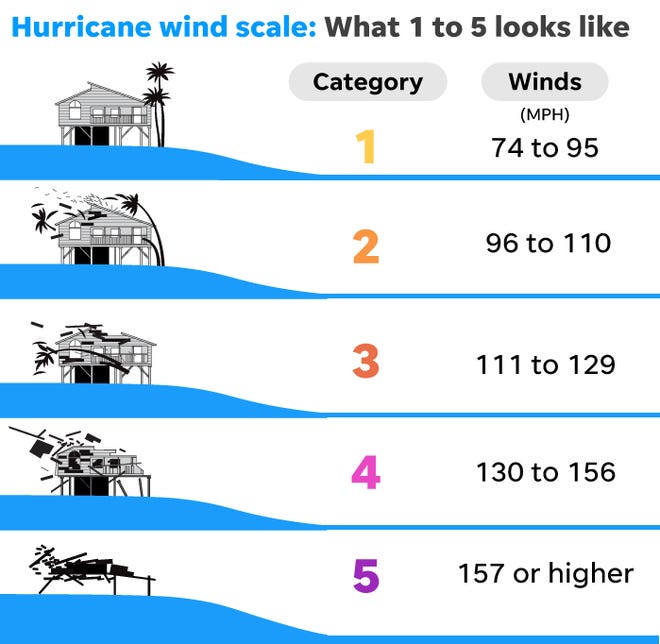- The scale was originally developed by structural engineer Herbert Saffir in 1969.
- Hurricanes rated Category 3 and higher are known as major hurricanes.
- This scale does not take into account other potentially deadly hurricane hazards.
From 1 to 5, the numbers used to categorize hurricanes are ingrained in the minds of millions of Americans from Texas to Maine.
This scale – officially known as the Saffir-Simpson Hurricane Wind Scale – is a rating based on maximum sustained wind speed, which ranges from 74 to 157 mph, or higher.
The scale was developed by structural engineer Herbert Saffir in 1969 as part of a United Nations project. It was later adapted by meteorologist Robert Simpson in the early 1970s, and it has been an integral tool for alerting the public about the possible impacts of various intensity hurricanes ever since, the National Hurricane Center said.
The scale does not take into account potentially deadly hurricane hazards such as storm surge, rainfall flooding and tornadoes.
Hurricane Ian live updates:Hurricane Ian nears Category 5 status, closes in on Florida
The Saffir-Simpson scale differs from the Fujita tornado damage scale in a fundamental way, according to the American Meteorological Society Weather Book. Meteorologists assign tornadoes a Fujita scale ranking only after examining the damage the tornado has done; the hurricane center assigns categories based on estimates of the hurricane’s fastest sustained wind speed.
The Saffir-Simpson scale provides examples of the type of damage and impacts in the USA associated with winds of the indicated intensity. In general, damage rises by about a factor of four for every category increase.
Though all hurricanes produce life-threatening winds, hurricanes rated Category 3 and higher are known as major hurricanes. Major hurricanes can cause devastating to catastrophic wind damage and loss of life. Hurricanes of all categories can produce deadly storm surge, rain-induced floods and tornadoes.
These hazards require people to take protective action, including evacuating from areas vulnerable to storm surge.
WHAT IS A FLASH FLOOD WATCH OR WARNING? Here’s what to know about this deadly weather hazard
WHAT IS A TORNADO? Everything you need to know about these violent storms
Category 1 hurricane: 74-95 mph
Very dangerous winds will produce some damage: Well-constructed frame homes could have damage to roof, shingles, vinyl siding and gutters. Large branches of trees will snap, and shallowly rooted trees may be toppled. Extensive damage to power lines and poles probably will result in power outages that could last a few to several days.
Category 2 hurricane: 96-110 mph
Extremely dangerous winds will cause extensive damage: Well-constructed frame homes could sustain major roof and siding damage. Many shallowly rooted trees will be snapped or uprooted and block numerous roads. Near-total power loss is likely, including outages that could last from several days to weeks.
Category 3 hurricane (major): 111-129 mph
Devastating damage will occur: Well-built framed homes may incur major damage or removal of roof decking and gable ends. Many trees will be snapped or uprooted, blocking numerous roads. Electricity and water will be unavailable for several days to weeks after the storm passes.
Category 4 hurricane (major): 130-156 mph
Catastrophic damage will occur: Well-built framed homes can sustain severe damage with loss of most of the roof structure and/or some exterior walls. Most trees will be snapped or uprooted and power poles downed. Fallen trees and power poles will isolate residential areas. Power outages will last weeks to possibly months. Most of the area will be uninhabitable for weeks or months.
Category 5 hurricane (major): 157 mph or higher
Catastrophic damage will occur: A high percentage of framed homes will be destroyed; there will be total roof failure and wall collapse. Fallen trees and power poles will isolate residential areas. Power outages will last for weeks to possibly months. Most of the area will be uninhabitable for weeks or months.


